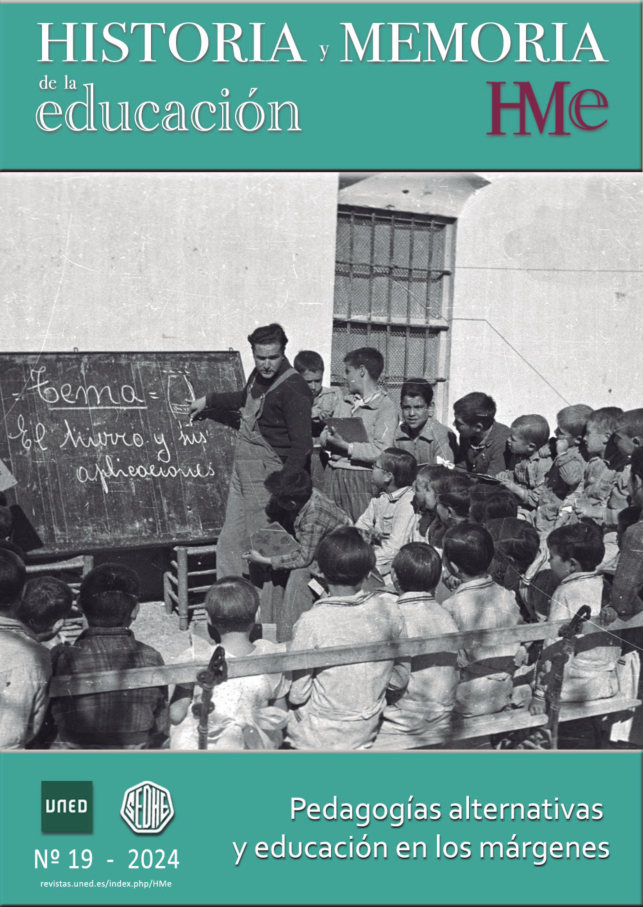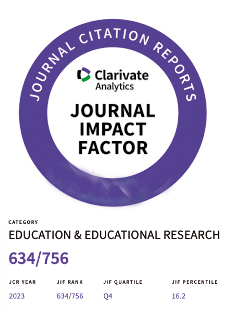«‘¡Mujer! Quiero hablar contigo...’ La construcción de la feminidad a través de las revistas cinematográficas durante el primer franquismo
DOI:
https://doi.org/10.5944/hme.19.2024.36539Palabras clave:
Primer franquismo, Educación sentimental, Estrellas cinematográficas, Feminidad, SexualidadResumen
Las revistas cinematográficas fueron un instrumento de la educación informal de las mujeres durante el primer franquismo. A través de sus páginas, contribuyeron a difundir el ideal de feminidad nacionalcatólico basado en la domesticidad y la maternidad. Sin embargo, este discurso estuvo plagado de contradicciones, que permitían que fuera reapropiado por las lectoras en un sentido diferente al pretendido por sus creadores. Un proceso que se dio en distintos ámbitos, pero que concernía especialmente a uno de los pilares del régimen: la familia. Las estrellas de cine, particularmente las de Hollywood, fueron empleadas como modelos para ejemplarizar actitudes tanto positivas como negativas. Se trataba asimismo de transmitir el mensaje de la superioridad de la tradición española frente a la penetración de la modernidad cosmopolita. Sin embargo, este esfuerzo por la educación sentimental de las jóvenes chocó a menudo con la incongruencia de los planteamientos y con la fascinación que despertaban las figuras que se criticaban. Igualmente otro gran campo de batalla en el adoctrinamiento de las mujeres fue el de la moralidad sexual. Pero nuevamente al emplear de manera simultánea la exhibición del cuerpo femenino, en fotografías de carácter seudo-erótico, para el placer visual masculino abrían la posibilidad que algunas mujeres transformaran esa imagen concebida como un objeto de deseo en un sujeto sexual potencialmente activo.
Descargas
Citas
Agulló Díaz, Carmen. «Azul y rosa: Franquismo y educación femenina». En Estudios sobre la política educativa durante el franquismo, editado por Alejandro Mayordomo Pérez, 243-303. Valencia: Universitat de València, 1999.
Álvarez Rodrigo, Álvaro. Fisuras en el firmamento. El desafío de las estrellas de cine al ideal de feminidad del primer franquismo. Valencia: Publicacions de la Universitat de València, 2022.
Álvarez Rodrigo, Álvaro. «La voz de una autoridad heterodoxa sobre el amor en el primer franquismo. Los consultorios sentimentales de Amparo Rivelles». Pasado y memoria 23 (2021): 260-282.
Barrera, Begoña. «Estilos emocionales y censuras culturales: La Sección Femenina en la posguerra». Ayer 124, no. 4 (2021): 251-276.
Basinger, Jeanine. A Woman’s View: How Hollywood Spoke to Women, 1930–1960. Middletown: Wesleyan University Press, 1995.
Buszek, Maria Elena. Pin-up grrrls: Feminism, sexuality, popular culture. London: Duke University Press, 2006.
Cenarro, Angela. «La Falange es un modo de ser (mujer): discursos e identidades de género en las publicaciones de la Sección Femenina (1938-1945)». Historia y política 37 (2017): 91-120.
Cenarro, Angela. La sonrisa de Falange: Auxilio Social en la Guerra Civil y en la posguerra. Barcelona: Crítica, 2006.
Di Febo, Giuliana. «La cuna, la cruz y la bandera. Primer franquismo y modelos de género». En Historia de las mujeres en España y América Latina. Vol. IV, editado por Isabel Morant, 217-237. Madrid: Cátedra, 2005.
Dyer, Richard. Las estrellas cinematográficas: Historia, ideología, estética. Barcelona: Paidós, 2001.
Expósito García, Mercedes. De la garçonne a la pin-up: Mujeres y hombres en el siglo XX. Madrid: Cátedra, 2016.
Foucault, Michel. Historia de la sexualidad. 1. La voluntad de saber. Madrid: Siglo XXI, 1978.
Graham, Helen. «Gender and the State: Women in the 1940s». En Spanish cultural studies, editado por Helen Graham y Jo Labanyi, 182-195. Oxford: Oxford University Press, 1995.
Higashi, Sumiko. Stars, fans, and consumption in the 1950s: Reading Photoplay. Nueva York: Palgrave MacMillan, 2014.
Kuhn, Annette. The power of the image: Essays on representation and sexuality. Londres: Routledge, 2013.
León Aguinaga, Pablo. Sospechosos habituales. El cine norteamericano, Estados Unidos y la España franquista, 1939-1960. Madrid: Consejo Superior de Investigaciones Científicas, 2010.
Martín Gaite, Carmen. Usos amorosos de la postguerra española. Barcelona: Anagrama, 2002.
McCracken, Ellen. Decoding Women’s Magazines: From Mademoiselle to Ms. Londres: MacMillan, 1993.
McLean, Adrienne L. Being Rita Hayworth: labor, identity, and Hollywood stardom. New Brunswick/New Jersey: Rutgers University Press, 2004.
Morant i Ariño, Antonio. «"Para influir en la vida del estado futuro": Discurso - y práctica- falangista sobre el papel de la mujer y la feminidad, 1933-1945». Historia y política 27 (2012): 113-141.
Morcillo, Aurora. En cuerpo y alma: Ser mujer en tiempos de Franco. Madrid: Siglo XXI, 2015.
Mulvey, Laura. «Visual pleasure and narrative cinema». Screen 16, no. 4 (1975): 6-18.
Nieto Ferrando, Jorge. Cine en papel: Cultura y crítica cinematográfica en España: (1939-1962). Valencia: Filmoteca Valenciana, 2009.
Nieto Ferrando, Jorge y José Enrique Monterde. La prensa cinematográfica en España (1910-2010). Madrid: Shangrila, 2018.
Pinilla García, Alfonso. «La mujer en la posguerra franquista a través de la Revista Medina (1940-1945)». Arenal 13, no. 1 (2006): 153-179.
Richmond, Kathleen. Las mujeres en el fascismo español: La Sección Femenina de la Falange, 1934-1959. Madrid: Alianza, 2004.
Roca i Girona, Jordi. De la pureza a la maternidad: La construcción del género femenino en la postguerra española. Madrid: Ministerio de Educación y Cultura, 1996.
Rodríguez López, Sofía. «Mujeres perversas. La caricaturización femenina como expresión de poder entre la guerra civil y el franquismo». Asparkía 16 (2005): 177-198.
Stacey, Jackie. Star gazing: Hollywood cinema and female spectatorship. London: Routledge, 1994.
Trindade, Luís. «Vicarious passions: the private life of Hollywood stars in 1950s Portuguese magazines». European Review of History: Revue Européenne d'Histoire 27, no. 4 (2020): 429-449.
Vincent, M. (2006). La reafirmación de la masculinidad en la cruzada franquista. Cuadernos de Historia Contemporánea, 28, 135-151.
Descargas
Publicado
Cómo citar
Número
Sección
Licencia
Derechos de autor 2023 Historia y Memoria de la Educación

Esta obra está bajo una licencia internacional Creative Commons Atribución-NoComercial 4.0.

Reconocimiento – NoComercial (by-nc 4.0): Se permite la generación de obras derivadas siempre que no se haga un uso comercial. Tampoco se puede utilizar la obra original con finalidades comerciales.










